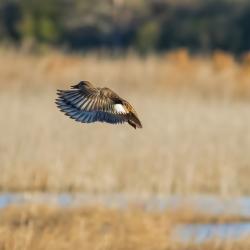A visit to Lake Mattamuskeet is a must see in any bird photography adventure in OBX, NC. Although the lake averages only two to three feet deep, it is one of the most beautiful lakes in Hyde County, west of the Outer Banks and is known for being a great birding and fishing destination.
Lake Mattamuskeet is the largest natural lake in North Carolina. This 40,000 acre lake is a wetlands depression that fills with rain water and the natural runoff from the land around it. Strangely enough, there are no underground springs or headwaters feeding into the huge lake. Lake Mattamuskeet is one of a number of Carolina Bay lakes of disputed origin. An Indian legend attributes its formation to a fire that burned for thirteen moons, which is equivalent to one year. Scientists cite the possibility of a prehistoric meteor shower or underground peat fires in speculating about how lake Mattamuskeet formed.
The last may be the most likely theory as the NC Wildlife service has had problems in the Outer Banks area due to the high concentration of peat in the soil. Peat is partially decomposed plant matter formed in wetlands that can be harvested as fuel, the first step in the formation of coal. North Carolina's coastal plain region has about 500 square miles of peat that can be up to 15 feet thick in some places.
Lake Mattamuskeet is said to be home of more than 800 species of wildlife and birds, and the lake makes up most of the 50,000 acre Mattamuskeet Wildlife Refuge. The Refuge’s strategic location along the Atlantic Flyway makes it a vitally important stopover for migrating birds. Over the past 35 years, up to 80 percent of the Northern Pintail Ducks and up to 30 percent of Green-wing Teal Ducks that annually migrate along the Flyway utilize Lake Mattamuskeet. In total, Lake Mattamuskeet Wildlife Refuge attracts more than 200,000 ducks, geese and swans from November through February. You are also sure to find other wildlife such as the Double-Breasted Cormant, Candian Geese, egrets, herons, deer, otters, nutria, Red-winged Black Birds, Bald Eagles, and sea gulls. Of the 800 species mentioned above, there are more than 200 species of birds around Lake Mattamuskeet for part or all of each year.
Lake Mattamuskeet is perfect for the run and gun style of bird photography as you have ready access to various birds from your car. No long hikes needed. Most of the photographs captured were from leaning out the car window, stepping out to the car, or at the many overlooks. Lake Mattamuskeet's East Main Drive is a 5-mile long gravel road bordering the southern shore of Lake Mattamuskeet. A variety of mammals and birds can be seen along this drive, as well as along the 3-mile long entrance road to the wildlife refuge headquarters. In addition, there is a short nature trail near the headquarters and miles of grassed dikes crisscrossing the entire refuge.
During our visit, egerts and herons seems to prefer fishing holes along the causeway while the ducks, geese, and swans were gathered in abundance within the Lake Mattamuskeet Wildlife Refuge itself not far from the entrance. If you are lucky and quick, you can drive up on a heron or a egert along the causeway and snap off a photograph. If he flies away before you get the photograph, wait a few minutes. They will usually land a few short distance away and often times return to the very same spot to their favorite fishing hole. We spent much of our time sneaking up on a brilliant array of Pintail, Shoveler, Mallard, Gadwall, and Hooded Merganser Ducks for the perfect photograph.
During our visit, there was a Bald Eagle family nesting in the trees at Lake Mattamuskeet Charles Kurault Overlook. We saw two Bald Eagles, but we didn't see any baby birds. Charles Kurault Overlook is a great for landscape photography as well, There is an interpretive panel, viewing scope, and restrooms there for your convenience.
Lake Mattamuskeet Wildlife Refuge is open daylight hours; however, be sure to check hunting schedules as parts of the wildlife refuge are shut off during hunting hours. Be sure to come with a full tank of gas and pack a lunch as Lake Mattamuskeet it is in a remote area.
We were able to view plenty of birds and wildlife throughout the day, but the morning sunlight made beautiful photographs against the grassy marshlands. On one such morning, we found a young deer peering out at us in a grass outcropping in the middle of the water. Once we got out of the car, the deer strolled on deeper into the wetlands and disappeared.



































